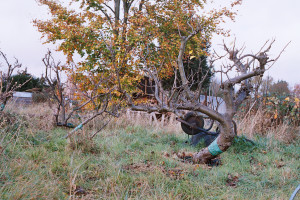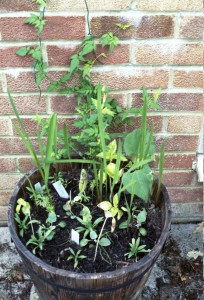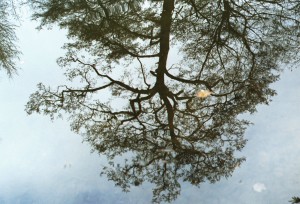‘Twenty years ago at a conference I attended of theologians and professors of religion, an Indian Christian friend told the assembly, “We are going to hear about the beauties of several traditions, but that does not mean we are going to make a fruit salad.” When it came to my turn to speak, I said, “Fruit salad can be delicious! I have shared the Eucharist with Father Daniel Berrigan, and our worship became possible because of the sufferings we Vietnamese and Americans shared over many years.” … I do not see any reason to spend one’s whole life tasting just one kind of fruit. We human beings can be nourished by the best values of many traditions.’
So begins Thich Nhat Hanh’s book ‘living buddha, living christ’, the first of his books that I read.
I, too, like fruit salad, and I love to learn about other people’s faiths and how they apply that faith in their lives.
I have, however, learnt that in this as in everything else, moderation is essential. Otherwise it is quite possible to end up with spiritual indigestion. I learnt this very clearly over a memorable few days when I overate physically and spiritually.

On a Saturday evening during a course at Woodbrooke learning about Islam, our group went to a mosque in Birmingham and then on to a Sufi gathering nearby. At the mosque we were shown round and given plenty of opportunity to ask questions, and offered refreshments (we managed not to consume too much, we were already well fed since we were staying at Woodbrooke). The Sufis welcomed us to their evening of chanting and recalling the name of Allah. We were encouraged to join in if we wished (I did wish) and I felt very much at home (if I lived in Birmingham I probably would have found a way to go there again). This was followed by an opportunity to talk and ask questions very informally over delicious tea, pakoras, and lots of other food. It was impossible not to eat while listening and learning in fascination.
Having returned home, Monday evening was our regular monthly SGI Buddhist discussion meeting. After the chanting, teaching, discussion and entertainment, there was (you’ve guessed) tea and cake. It was someone’s birthday so there was more cake than usual, which could not politely be refused. Lots more spiritual experience and learning, lots more cake.
Tuesday evening was the appointed time for our local Interfaith association AGM. An interesting speaker giving more food for thought, followed by refreshments and a chance to talk and listen to one another. All thoroughly enjoyable and fascinating, but I was beginning to feel overloaded by it all. Just so much to take in. Physical and spiritual indigestion.
Fortunately the rest of the week was rather quieter. Overall I don’t regret any of this. It may have been easier if it had been more spaced out, but it is often necessary to seize the opportunities to share and learn (and eat) together when they occur.

Like the opportunity I had a few years ago to attend a meeting at the Zoroastrian centre at Rayners Lane. There are not many Zoroastrians, and hence they have very few centres outside India,and we are blessed that this one is so close to us. There was a formal large scale interfaith meeting in the afternoon, with an invitation to stay afterwards for a fire ceremony and then a meal (yes, more food). I was able to accept the invitation to stay into the evening, and it was a delight and privilege to experience the ceremony, even if I had little understanding of what was happening. Sharing the meal afterwards gave us a chance to get to know a few of the other visitors and some of the Zoroastrians, to learn more about their traditions and what had happened during the ceremony. After the meal, we were privileged to be taken upstairs to the worship area, at the top of this converted cinema,where a flame is kept burning continuously and people can pray privately as well as participate in community ceremonies.
I confess that my regular spiritual practice is a form of fruit salad. I like to sit on the floor, and often use an incense stick or a candle as an aid to meditation (though the meditation may become expectant waiting or upholding prayer). The prayer beads that I was given by a Krishna devotee (with a lesson in how to chant Hare Krishna) are another favourite aid to centring down, or are wrapped round my wrist as an aid to remembering all those who need to be prayed for and upheld. I try to be mindful as I walk, wash the dishes, prepare food and generally go about my daily life (though I forget very frequently). I attend meeting for worship once or twice a week, sangha meetings when I can, intefaith gatherings likewise, and, yes, will chant almost anything with any group that practises that way. As a Buddhist friend once commented to me (having just suggested to one person in our discussion group that the practice was there, she was welcome to ‘suck it and see’ if it suited her) ‘the trouble with you is that you don’t just want taste one sort of sweet, you want to try one from every jar in the shop!’ He was right,and that’s probably why I still get spiritual indigestion from time to time. But I’m unrepentant about liking fruit salad (and cake too!).
Following Luanne’s example, and since this post has been all about food, here are some recipes:
Fruit Salad
Take a selection of fresh fruit (you can use fruit that is slightly damaged or bruised, just cut those bits out), about one serving per person.
Eg for four, 1 apple, 1 banana, 1 pear, 1 orange.
Clearly this works well for 4 people or more, if there are only one or two people, you do need to make enough to serve them several times. One sliced apple for one person really isn’t a fruit salad.
Any fruit that you would eat fresh is fine. Cut into pieces and mix in a bowl with some fruit juice.
Tinned fruit (and the juice it comes in) or fruit that has been preserved by freezing can be used alongside the fresh fruit. A splash of liqueur is a good addition if alcohol is acceptable to all who will be eating it. Serve alone, or with cream, ice cream, custard or Swedish Glacé (for vegans)
 Photo: P Grant www.petespcs.co.uk
Photo: P Grant www.petespcs.co.uk
Fruit Teabread or Bara Brith
A reliable contribution for Quaker teas, study groups, interfaith AGMs, school fêtes, cake stalls and all manner of other occasions (especially as you get 2 loaves each time and it improves with keeping in an airtight container for up to four weeks)
Soak 1lb mixed dried fruit (use as wide a mixture as you like or have to hand) and 6oz sugar (any sort) in ½ pt warm tea over night or about 8hours.
Then mix in 1lb flour (I use ½ & ½ wholemeal/plain and 1 teaspoon baking powder, but all wholemeal works well too, or use self-raising and omit the baking powder), 1 egg (or use ‘no egg’ for a vegan version) and 2 tablespoons marmalade. Mix well, divide between 2 greased 1lb loaf tins and cook for about 1½ hours at gas mark 3. Allow to cool for 10 minutes in the tins before turning out on to a wire rack to finish cool. When cool store until required ,or just slice and eat, with or without butter.
Interfaith Pilgrimage – a Spiritual Fruit Salad
Westminster Interfaith organise excellent day long pilgrimages for peace in early June each year, visiting 5 or 6 different places of worship, often including the chance to participate in worship in at least one of them. Different places are visited each year. A good lunch is traditionally provided by a Sikh organisation from Birmingham. Travel may be by coach or by public transport, depending on the location.
Watford Interfaith Association run a smaller scale version each November visiting a synagogue, a mosque, 2 churches and a gurdwara, all within walking distance of each other for people of average fitness. It is good to walk together and talk along the way, but a car can be used if necessary. The fire brigade usually accompany the party, to learn and to support rather than because we are at risk of fires. The synagogue provide tea and cakes to set us up for the walk, the mosque will provide sweets and drinking water to sustain anyone who is flagging, and at the gurdwara a meal awaits the pilgrims at the end of the day.







